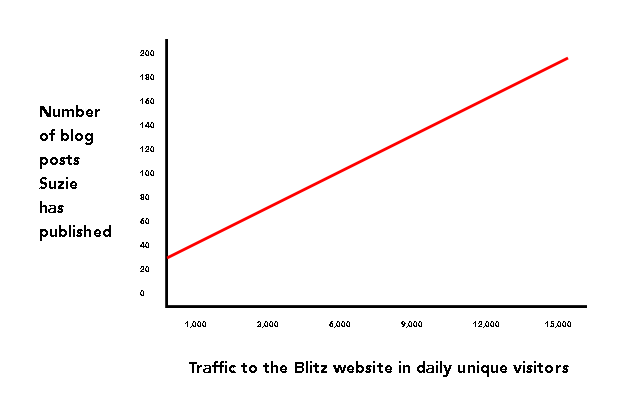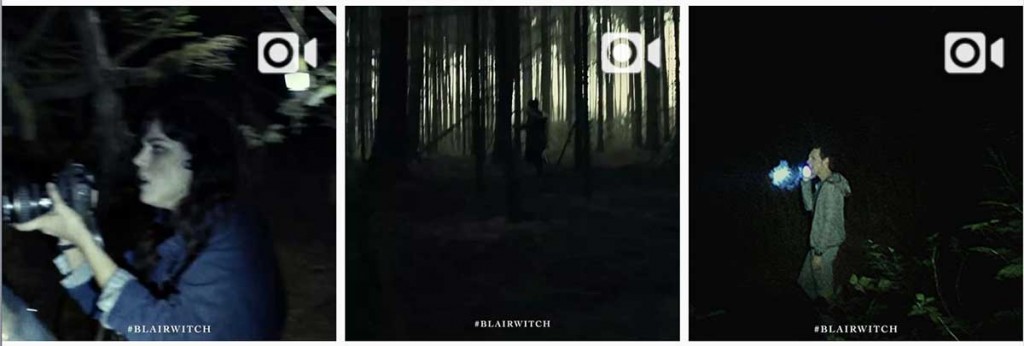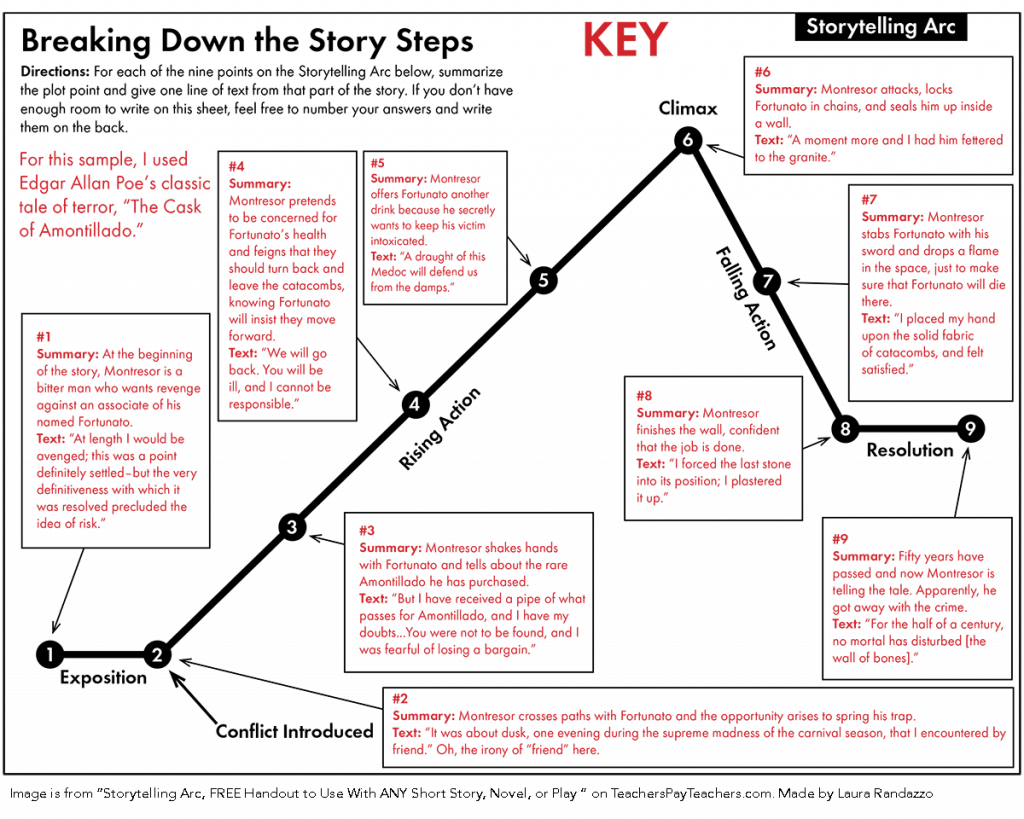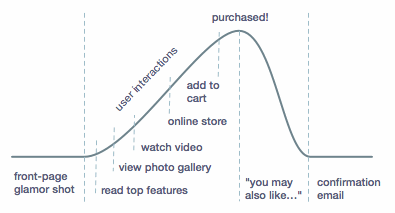
Let me tell you about Suzie McQueue.
She’s a successful content marketing manager.
There are a couple of ways I can tell you about Suzie. I could show you a graph, like this:

Or I could write you a technical whitepaper.
It would be written in “proper” dry business lingo, with convoluted sentences, laboriously documenting Suzie’s methodology from content ideation and freelancer resource strategy through to the optimal consumer behavior indexing.
Or I could tell you a story:
Suzie McQueue is the superstar content marketing manager at Blitz. She needs to sell lots and lots of product – a hairspray that makes hair stay clean for a week.
But poor Suzie has no budget. All she’s got is some writing and design skills. So she dives in and starts writing. Starts making funny, shareable images about what people look like when they don’t wash.
She tries a bunch of different content formats and a bunch of different content promotion tactics. Some work great; some fall flat. But pretty soon, she’s got an avid following among college students, new Moms, thru-hikers, and workaholic business executives.
Blitz is flying off the shelves.
Guess which version of Suzie’s story 99% of people would like best?
Yup – the story. Though for some of us wonky folk, the graph might make for a pretty picture to look at while we were being told the story. (More about that in a moment.)
There’s a lesson in this for content marketers: Stories sell.
But they grab our attention first, and then they hold it. Our poor little brains can’t help it – they’re wired to love and learn from stories.
If you can slip in the right call to action, at just the right time, stories will almost effortlessly bring your prospects through their buyers’ journey. Your prospects will travel all the way to customerhood, where they will hopefully live happily ever after.
You just have to know some basics about storytelling. Some ingredients, if you will.
Once again, there are a couple of ways I could explain this. This illustration might describe some of it.
And now… just for comparison… consider this graph of the customer journey from their first meeting with your brand, all the way through to their second order.
Interesting comparison, eh? Notice any similarities?
There’s a reason marketers are so into storytelling. What we do is very similar to what storytellers do.
Even some of the terms we use in marketing sound like storytelling. The “customer journey” sounds like a storytelling term. So does “engagement”…
Speaking of which…
Storytelling meets a dire need most content marketers have: It gets engagement. I’m sure you’ve seen the stats and heard the stories (that again… hmm) about how engagement rates are falling. We’ve written about it quite a lot here, including how to overcome the problem.
Well, one way is to use more stories. And so if you want to get more engagement, stories can be a way to do that.
The question is, how to pull this show off? Fortunately, Hollywood takes storytelling seriously – it’s their business. And so there’s a lot of Hollywood tricks we can borrow to make our marketing even better.
1. Visuals matter
Even if you’re talking about a low-budget, rough cut like “The Blair Witch Project”, visuals always make a difference. In fact, the rough and realistic visuals of “Blair Witch” were exactly what made the film extra-scary.
It was some pretty smart strategy on the director’s side to take what could have been a problem (low budget, so-so quality production) and make it into the film’s biggest strength.

2. So does authenticity
Take user generated content (like product review videos and written reviews and images posted on social media). Part of the reason user generated content is so convincing is that it’s not super-polished.
User generated content (“UGC” as some say) is clearly made by regular people. It doesn’t have high production value. That’s part of why it’s so much more trustworthy than the slick advertising brands put out.
These are real people making this content – they’ve got nothing more than a camera on their phone and a bookshelf for a background. They’re sharing about why they like the product out of true enthusiasm. That’s convincing.
3. Brevity works
A lot of us think that storytelling needs to be long-form. But that isn’t so. You can tell a story in six words. There’s actually a whole movement about the “6-word memoir”, including a TED Talk about it.
Try this with your brand/product. Tell its story in six words. Tell your Founder’s story in six words. Tell your customers’ stories, and your own stories.
It takes a little practice, but once you’ve got the six-word story format down, you won’t have any problem at all with super-short social media posts.
Interestingly enough, even six-word stories tend to fall into a format. It’s three sentences of two words each.
So something like: Lost house. Needed work. Found life.
Try it now. What’s the six-word story for this picture?

Or for this one?

*Give us your answers in the comments.
4. Promotion is essential
Wanna know a secret about Hollywood? They spend as much money on promoting a film as they do on creating it.
That’s a really interesting thing for us content marketers to know. A lot of us have heard that we should be spending as much time (and as much money) on promoting our content as we did on creating it. But very, very few of us actually do that.
5. Cliffhangers make your audience keep watching
We live in the age of distraction. This is even truer if you’re marketing online, or if you’re “just” trying to get your message across online (which is also marketing, of course).
Smart marketers don’t fight this. They know their audiences can be distracted at any moment. So they make their content easy to “consume” (or scan, if you’re talking about words). And they use story cliffhangers… gaps in the story that leave people wanting to know more.
Headlines are a kind of cliffhanger. Except when you leave too much of a gap, they’re clickbait.
Ever seen the technique of promoting a listicle (a blog post that’s a list of things) by saying, “#17 really blew me away”? That’s another type of cliffhanger. It dangles something interesting and irresistible in front of you… and makes you want to fill that gap.
Having each section of your content foreshadow the next section is a way to use cliffhangers, too. I could probably use one here.
6. Focus on people
Even if you’re in B2B marketing. Especially if you’re in B2B marketing.
Stories are one of the best ways to connect with people. And as the saying goes, “Nobody does business with a company. People do business with people.”
People do stories with people, too. Not with companies. So as you start developing story lines for your business, start honing in on individuals. You can absolutely tie those individual stories together to tell people about your company – but focus on the people first.
Stories about people pull another powerful string: Compassion. When we identify with another person, we almost automatically start having compassion for them. They’re like us, so we care about them.
This little principle is a lynchpin you can use to get people to care about your content, your products – even care about your business.
Conclusion
We all know how competitive content marketing has become. And most of us know that we’ll need to get better at it if we want to stay in the game.
Fortunately, there’s a lot of ways to get better at content marketing. We can focus more on what our audiences need, for instance. We can use a content marketing automation tool (Scoop.it Content Director) to save some time. We can follow best practices… and more.
And we can get old school, and go back to storytelling.
Back to you
What storytelling tactics are you using in your marketing? Tell us about them in the comments.
If you want to get 30 effective techniques to master content marketing along with valuable insights from 10+ influencers like Mark Schaefer, Rebecca Lieb, Lee Odden, Jason Miller or Ian Cleary, download our free eBook now!
Image by Jakob Owens




